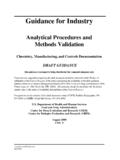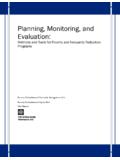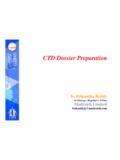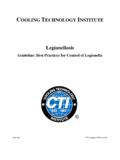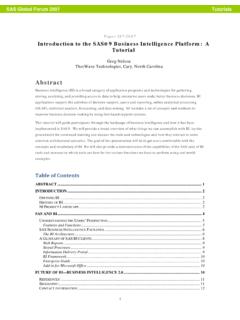Transcription of Regulatory Aspects of Pharmaceutical …
1 Regulatory Aspects of Pharmaceutical development and manufacturing in the 21st Century FDA perspective Moheb M. Nasr, PhD. ONDQA/CDER/FDA. Cortona Conference on QbD/PAT. Cortona, Italy September 20, 2010 1. Outline Status of Pharmaceutical manufacturing FDA 21st Century Initiative Recent ICH Quality Guidances Implementation of QbD. Progress and Challenges What has QbD Delivered So Far? Adaptation of new technologies What Should QbD Deliver in the Future in a Globalized Industry? Ongoing Research and Future Innovation Cortona Conference Concluding comments 2. Status of Pharmaceutical manufacturing Adequate and sufficient quality Several cost effective therapy options available High manufacturing cost Low efficiency and considerable waste Strong reliance on Regulatory oversight Low factory/equipment utilization rate Frequent manufacturing failures and product recalls Lack of coordination/integration among key business units (R&D, manufacturing , quality, Regulatory , etc.)
2 Slow to innovate and embrace new technologies Increase reliance on outsourcing 3. FDA 21st Century Initiative Objectives: Encourage the early adoption of new technological advances by the Pharmaceutical industry Facilitate industry application of modern quality management techniques, including implementation of quality systems approaches Encourage implementation of risk-based approaches Ensure that Regulatory review, compliance, and inspection policies are based on state-of- the-art Pharmaceutical science Enhance the consistency and coordination of September 2004 FDA's drug quality Regulatory programs 4. FDA and ICH Guidance Nov 2005 & Nov 2008. 2004. Sept be r 2005. Novem Sept 2006. June 200. 8. Nov 2008 April 2009 & Ongoing 5. Recent ICH Quality Guidances . Pharmaceutical development - Q8(R2). Describes good practices for Pharmaceutical product development Introduces concepts of design space and flexible Regulatory approaches Introduced and elaborated on QbD concepts 6.
3 Quality by Design Linking Process - Product - Patient Clinical Patient Outcome Critical Quality Product Attributes Material Attributes &. Process Process Parameters 8. Example QbD Approach - Q8(R2). Product profile Quality Target product profile (QTPP). CQAs Determine critical quality attributes (CQAs). Link raw material attributes and process Risk assessment parameters to CQAs and perform risk assessment Design space Develop a design space Control Design and implement a control strategy strategy Manage product lifecycle, including continual Continual Improvement improvement 9. Recent ICH Quality Guidance (cont.). ICH Q9 Quality Risk Management Describes a systematic process for the assessment, control, communication and review of quality risks Applies over product lifecycle: development , manufacturing and distribution Includes principles and examples of tools for quality risk management ICH Q10 Pharmaceutical Quality Systems Describes systems that facilitate establishment and maintainence of a state of control for process performance and product quality Facilitates continual improvement Applies to drug substance and drug product throughout product lifecycle 10.
4 Quality Risk Management Process - Q9. Process development Control Strategy development Continual Improvement11. (PQS) ICH Q10. Pharmaceutical Technology Commercial Product development Transfer manufacturing Discontinuation Investigational products GMP. Management Responsibilities Process Performance & Product Quality Monitoring System PQS Corrective Action / Preventive Action (CA/PA) System elements Change Management System Management Review Knowledge Management Enablers Quality Risk Management 12. ICH Where do we go from here? ICH Quality Implementation Work Group (Q-IWG). ICH Q11 Drug Substance ICH Q 3(D) - Heavy Metals ICH M7 Genotoxic Impurities 13. ICH Q-IWG. Q&A doc: Case studies and collaborative efforts Training workshops How Q8, Q9 and Q10 should work together June 2-4, 2010 Tallinn, Estonia October 6-8, 2010 Washington, DC. October 25-27, 2010 Tokyo, Japan 14. 15. ICH Quality Implementation Workshop Workshop features: How Q8, Q9, and Q10 can benefit Pharmaceutical development , manufacturing , Regulatory assessment, scale up to commercial operations and GMP-inspection A case study demonstrating opportunities for using the combination of Q8, Q9, and Q10.
5 Discussions to develop solutions to implementation challenges Interaction between regulators and industry experts Four specialized breakout discussions covering Design Space, Control Strategy, Pharmaceutical Quality System, and Quality Risk Management Participants will attend each discussion 16. ICH Quality Implementation Workshop Feedback from the workshops will be used by the ICH Q-IWG to further facilitate harmonized implementation of ICH Q8, Q9 and Q10. The final workshop materials and outcomes will be presented to regulators and industry in the three ICH. regions and will be made available to other regions as well. The workshop material is intended to be used for internal training purposes by industry and regulators. 17. Demystification of QbD. QbD is a systematic approach to Pharmaceutical development and manufacturing using: Modern scientific and quality risk management (QRM). principles Quality control strategies based on product and process understanding development and manufacturing information to be included in Regulatory submissions Regulatory decisions must be based on scientific and QRM principles 18.
6 Implementation of QbD in FDA Human Drug Programs Office of New Drug Quality Assessment (ONDQA). 2005 CMC Pilot program QbD Implementation Outside the CMC Pilot Office of Biotechnology Products 2008 Biotechnology Pilot Program Office of Generic Drugs Question Based Review (QBR). 19. ONDQA - Findings from CMC Pilot Program Provided valuable experience for industry and FDA in implementing QbD. Elements of QbD in submissions Risk assessments Design spaces Proposals for flexible Regulatory approaches Risk-based Regulatory decisions were enabled Learning has been incorporated into ICH Q8R. Refinement of concepts still ongoing 20. ONDQA - Modern Control Strategies in Recent QbD. Applications Translating process understanding into effective controls On-line and in-line measurement instruments Effective sampling strategies Feed-back and feed-forward control systems Modern manufacturing approaches Lean manufacturing and real-time release testing Continuous manufacturing Continual Improvement Maintenance and update of process and analytical models Utilization of process data to update control models ( , Multivariate statistical process control).
7 Knowledge retention and risk management updates 21. Control Strategy Example - Real Time Release Testing (RTRT). NIR Spectroscopy NIR Monitoring Laser Diffraction (At-Line). Blend Uniformity Particle Size Identity Assay Raw materials & API to Excipient API dispensing ratio Specifications based on product Roller Tablet Pan Dispensing Blending Sifting compaction Compression Coating 22. ONDQA - Recent QbD Experiences Number of QbD meetings and applications have been increasing Applications containing QbD elements, outside of pilot 15 NDAs 20 INDs 6 supplemental NDAs New proposals containing challenging Regulatory approaches Additional experience is helping to harmonize review approaches and Regulatory decisions 23. QbD in Biotechnology Mock case studies developed OBP Pilot Program FR Notice July 2, 2008. To consider quality-by-design (QbD) approaches to unit operations in supplements (10) as well as original applications (5). To explore the use of protocols submitted under (21.)
8 CF (e) and (e)). 5 applications accepted (3 full BLA, 2 Supplements). more under consideration 24. Generic Drug Quality Assessment OGD has developed a question-based review (QbR) for quality evaluation of generic drug applications Several Industry/OGD workshops goal to move toward a common understanding of QbD for generics Agreement to address MR dose forms (formulation and manufacturing process). ANDA submission requirements for MR. products may change in the future 25. What has QbD Delivered So Far? Focus on systematic Pharmaceutical development Utilization of formal quality risk management in Pharmaceutical development , control strategy, change control and Regulatory processes Collaborative scientific interaction between manufacturers and regulators Harmonization and collaboration among global regulators Opportunities for Pharmaceutical innovation (continuous manufacturing , RTRT, PAT tools, etc.). Flexibility in manufacturing and operations 26. What has QbD Delivered So Far?
9 Cont. Identification of some scientific and Regulatory gaps (analytical, modeling, biopharm, characterization, etc.). Effective collaboration between CMC and clinical reviews Improved interactions between review and inspection More diverse and high quality reviewers on board Changes in the review process and the interaction with industry development of QMS for CMC review 27. Adaptation of New Technologies QbD paradigm supports adaptation of new technologies and development approaches Better/more utilization of DOEs and QRM. Chemometric based methods for real time determinations of tablet potency Multivariate models as surrogates for traditional release tests ( dissolution). Multivariate models for statistical process control Advanced analytics and process controls (PAT). Continuous manufacturing in lieu of batch processing 28. Example: Real Time Determination of Tablet Potency Blend Uniformity determined by on-line NIR. Adjustable blending time Blend Assay Fast response by NIR.
10 Tablet CU determined during compression On-line measurement of active content by NIR. Fast turn around Tablet Assay Fully automated by NIR. Corrective action feasible 29. Example: Multivariate Model for Predicting Dissolution Calibration Data Qualitative Assessment B1. PC2. by PCA. B2. B3. PROCESS DATA. B4. PC1. RAW MATERIAL manufacturing DATA Data Quantitative Prediction Measured by PLS. 30. Predicted Example: Multivariate Model for Statistical Process Control MSPC (Multivariate Statistical Process Control). model for a unit operation compression Built from multiple batch data All batches had acceptable quality product New batch data projected onto the MSPC model to demonstrate conformance 31. Conceptual Example of Continuous manufacturing Continuous Continuous Blending Compression Receiving Granulation On-line Assay Particle Size Weight & Hardness Distribution Continuous Film Coating Continuous Blending Digital Imaging At-line Dissolution Model Chemical Properties (release).


